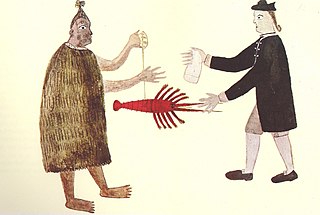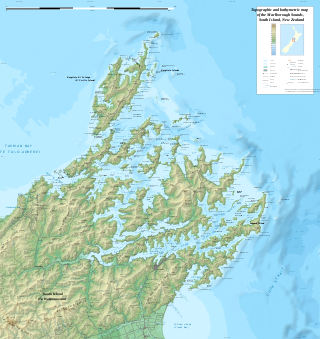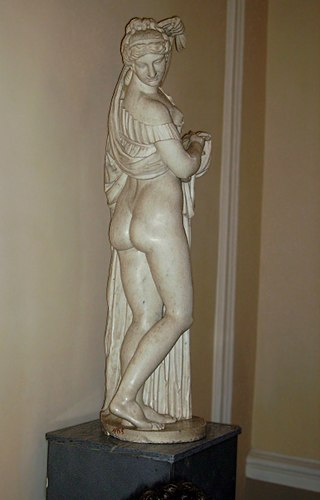
The Treaty of Waitangi, sometimes referred to as Te Tiriti, is a document of central importance to the history of New Zealand, its constitution, and its national mythos. It has played a major role in the treatment of the Māori people in New Zealand by successive governments and the wider population, something that has been especially prominent from the late 20th century. The treaty document is an agreement, not a treaty as recognised in international law, and has no independent legal status, being legally effective only to the extent it is recognised in various statutes. It was first signed on 6 February 1840 by Captain William Hobson as consul for the British Crown and by Māori chiefs from the North Island of New Zealand.

The Marlborough Sounds are an extensive network of sea-drowned valleys at the northern end of the South Island of New Zealand. The Marlborough Sounds were created by a combination of land subsidence and rising sea levels. According to Māori mythology, the sounds are the prows of the many sunken waka of Aoraki.

Indecent exposure is the deliberate public exposure by a person of a portion of their body in a manner contrary to local standards of appropriate behavior. Laws and social attitudes regarding indecent exposure vary significantly in different countries. It ranges from outright prohibition of the exposure of any body parts other than the hands or face to prohibition of exposure of certain body parts, such as the genital area, buttocks or breasts.

Exhibitionism is the act of exposing in a public or semi-public context one's intimate parts – for example, the breasts, genitals or buttocks. The practice may arise from a desire or compulsion to expose oneself in such a manner to groups of friends or acquaintances, or to strangers for their amusement or sexual satisfaction, or to shock the bystander. Exposing oneself only to an intimate partner is normally not regarded as exhibitionism. In law, the act of exhibitionism may be referred to as indecent exposure or exposing one's person, or by other expressions.

Robin Brunskill Cooke, Baron Cooke of Thorndon, was a New Zealand judge and later a British Law Lord and member of the Judicial Committee of the Privy Council. He is widely considered one of New Zealand's most influential jurists, and is the only New Zealand judge to have sat in the House of Lords. He was a Non-Permanent Judge of the Court of Final Appeal of Hong Kong from 1997 to 2006.

Anasyrma composed of ἀνά ana "up, against, back", and σύρμα syrma "a dragging motion"; plural: anasyrmata (ἀνασύρματα), also called anasyrmos (ἀνασυρμός), is the gesture of lifting the skirt or kilt. It is used in connection with certain religious rituals, eroticism, and lewd jokes. The term is used in describing corresponding works of art.

The Te Tai Hauauru by-election was a by-election in the New Zealand electorate of Te Tai Hauāuru, one of the Māori electorates. The date set for the by-election was 10 July 2004. It saw the re-election of Tariana Turia, a former MP for the Labour Party and now co-leader of the Māori Party.
Te Ringa Mangu Netana "Dun" Mihaka was a New Zealand Māori activist, author, and political candidate.

Toplessness refers to the state in which a woman's breasts, including her areolas and nipples, are exposed, especially in a public place or in a visual medium. The male equivalent is known as barechestedness.

Buttock cleavage is minor exposure of the buttocks and the intergluteal cleft between them, often because of low-rise pants. The crena is a formal term for the cleft between the buttocks.

Tāme Wairere Iti is a New Zealand Māori activist, artist, actor and social worker. Of Ngāi Tūhoe descent, Iti rose to prominence as a member of the protest group Ngā Tamatoa in 1970s Auckland, becoming a key figure of the Māori protest movement and the Māori renaissance. Since then, he has become a renowned activist for the rights of Māori and the process of co-governance and decolonisation.
Clothing laws vary considerably around the world. In most countries, there are no laws which prescribe what clothing is required to be worn. However, the community standards of clothing are set indirectly by way of prosecution of those who wear something that is not socially approved. Those people who wear insufficient clothing can be prosecuted in many countries under various offences termed indecent exposure, public indecency, nudity or other descriptions. Generally, these offences do not themselves define what is and what is not acceptable clothing to constitute the offence, and leave it to a judge to determine in each case.
The Māori renaissance, as a turning point in New Zealand's history, describes a loosely defined period between 1970 and the early 2000s, in which Māori took the lead in turning around the decline of their culture and language that had been ongoing since the early days of European settlement. In doing so, social attitudes towards Māori among other New Zealanders also changed.
"Sit on My Face" is a short song written by Eric Idle and performed by the members of the comedy troupe Monty Python, which originally appeared on the album Monty Python's Contractual Obligation Album and later appeared on the compilation Monty Python Sings. The song's lyrics are sung to the melody of "Sing As We Go" (1934) by Harry Parr-Davies, made popular by Gracie Fields. The opening gives way to the voices of The Fred Tomlinson Singers singing "Sit on my face and tell me that you love me." The remaining lyrics contain numerous references to fellatio and cunnilingus, such as "when I'm between your thighs you blow me away" and "life can be fine if we both 69".
The Māori protest movement is a broad indigenous rights movement in New Zealand. While there was a range of conflicts between Māori and European immigrants prior to the signing of the Treaty of Waitangi in 1840, the signing provided one reason for protesting. Disagreements in the decades following the signing sometimes included war.
Lubna Ahmed al-Hussein is a Sudanese Muslim, media worker and activist who came to international attention in July 2009, when she was prosecuted for wearing trousers. Her case became a cause célèbre, with organisations such as the Arabic Network for Human Rights Information and Amnesty International issuing statements in support.
In Canada, topfreedom has primarily been an attempt to combat the interpretation of indecency laws that considered a woman's breasts to be indecent, and therefore their exhibition in public an offence. In British Columbia, it is a historical issue dating back to the 1930s and the public protests against the materialistic lifestyle held by the radical religious sect of the Freedomites, whose pacifist beliefs led to their exodus from Russia to Canada at the end of the 19th century. The Svobodniki became famous for their public nudity: primarily for their nude marches in public and the acts of arson committed also in the nude.

The judiciary of New Zealand is responsible for the system of courts that interprets and applies the laws of New Zealand. It has four primary functions: to provide a mechanism for dispute resolution; to deliver authoritative rulings on the meaning and application of legislation; to develop case law; and to uphold the rule of law, personal liberty and human rights. The judiciary is supported in its work by an executive department, the Ministry of Justice.

Naturism refers to a lifestyle of practising non-sexual social nudity in private and in public, and to the cultural movement which advocates and defends that lifestyle. Both are also known as "nudism". Naturist organisations have existed in New Zealand since the 1930s. Although not a daily feature of public life, social nudity is practised in a variety of other contexts in New Zealand culture.

In the United States, individual states have primary jurisdiction in matters of public morality. The topfreedom movement has claimed success in a few instances in persuading some state and federal courts to overturn some state laws on the basis of sex discrimination or equal protection, arguing that a woman should be free to expose her chest in any context in which a man can expose his. Other successful cases have been on the basis of freedom of expression in protest, or simply that exposure of breasts is not indecent.















